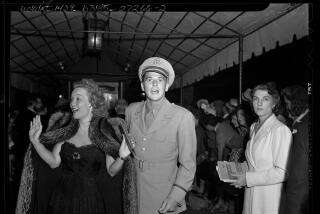The Changing Attitudes on Adultery
- Share via
Remember Lancelot, Guinevere and Arthur? Their adultery has been called the “fantasy” of the Christian world. Technically the sexual act between a married person and a member of the opposite sex who is not the spouse, adultery rose to the height of transgression when it was included in the Ten Commandments. Its appeal was enhanced by the medieval tradition of courtly love, which left the illicit trio a staple of Western culture.
But no culture is static, and according to the British sociologist Annette Larson, attitudes toward and the practice of adultery are a good measure of societal change. In an egalitarian and individualist age, she says, everyone feels entitled to escape into the arms of a gallant or beautiful lover, not merely in fantasy like the Victorian fans of “Idylls of the King,” but as a scenario to be lived.
Social revolutions are hard to measure. Larson, who is now at the Institute for Human Development at UC Berkeley, collected data in Britain between 1982 and 1984 while she was at Brunel, the University of West London. She selected 578 subjects from volunteers who responded to newspapers and television appeals. They included women and men (in a ratio of 60 to 40) ranging from 22 to 83 years old. Although her study is limited to middle class, white Britons, Lawson finds their opinions are remarkably similar to surveys taken in the United States by women’s magazines. After allowances are made for the kind of individuals who are prepared, even anonymously, to discuss such intimate matters, her conclusions are still startling.
Until the 20th Century, British law dealt more severely with women who committed adultery. In a Parliamentary debate in 1857, the Lord Chancellor said that “A wife might without any loss of caste condone an act of adultery . . . but a husband could not condone a similar act on the part of the wife . . . as the adultery might be the means of palming spurious offspring on her husband.” Englishmen could get a divorce for any evidence of adultery, while Englishwomen had to prove that the adultery was incestuous or otherwise unnatural.
The double standard vanished in law and seems to be disappearing in practice as well. The biggest change, Lawson’s research reveals, is among people of both sexes under 35. In that group, adultery is becoming more commonplace and both men and women are seeking other liaisons sooner after marriage, and more often than their elder siblings and parents.
She identifies two factors that seem to have altered the nature of adultery. The first is the mood of the ‘70s, when sexual permissiveness was encouraged by the pop philosophical and psychological self-actualization movements. Regardless of their ages, individuals in Larson’s survey report that they first entered into adulterous relations between 1968 and 1978. One woman explained that she needed an affair to find the confidence to finish her education and get a job.
The second factor is the large-scale entry of women into the work force, especially into areas that had been all male. Women tend to follow the male model of behavior, Larson suggests, and like their male colleagues feel entitled to “something on the side.”
“Whereas sexual conquest and activity were once an exclusive prerogative and socially expected goal for men,” she says, “something akin to this has become equally desirable for women. Importantly, this has been done via a definition of female sexuality highly infused with male perceptions of sex.” But many women reported disappointment with these affairs. Whether or not female sexuality is inherently different from male sexuality, women have been used to expecting more than sex in a relationship. Larson senses that now men, especially younger men, are seeking intimacy and companionship from the other woman.
The new mix of men and women in the work place has altered social relations, including adultery. It works both ways apparently, for she reports that men who enter traditionally female dominated occupations such as nursing or social work decrease the number of their liaisons in line with the pattern for women. The study suggests that there has been a feminization of intimacy and a masculinization of opportunity.
Larson reports that many young Britons are marrying with either a tacit or articulated agreement that rejects sexual exclusivity. Their liaisons are only sexual and they usually tell each other about them.
Adulterers of both sexes are demanding better relationships. They tend to devalue the sexual act and value instead honesty within their marriages. Like aggrieved parties in the past, they report feelings of grief and betrayal on learning of a spouse’s liaison when the adulterer acted furtively. The wounded parties still find adultery painful, but it is not the sex they begrudge, it is the loss of intimacy.
More to Read
Sign up for Essential California
The most important California stories and recommendations in your inbox every morning.
You may occasionally receive promotional content from the Los Angeles Times.













